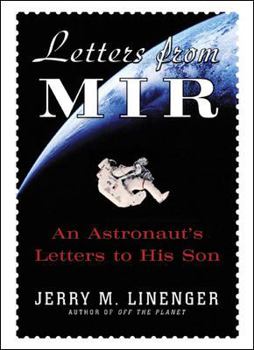Letters from Mir: An Astronaut's Letters to His Son
Select Format
Select Condition 
Book Overview
Jerry Linenger's five months aboard the Space Station Mir were anything but calm. They included a major fire, malfunctioning computer systems, and lost electrical and cooling power, among other... This description may be from another edition of this product.
Format:Hardcover
Language:English
ISBN:0071400095
ISBN13:9780071400091
Release Date:August 2002
Publisher:McGraw-Hill Companies
Length:224 Pages
Weight:0.78 lbs.
Dimensions:0.9" x 5.3" x 7.2"
Related Subjects
Aeronautical Engineering Aeronautics & Astronautics Astronomy Astronomy & Astrophysics Astronomy & Space Science Biographical Biographies Biographies & History Biography & History Engineering Essays & Correspondence Humanities Letters & Correspondence Literary Literary Criticism & Collections Literature Literature & Fiction Memoirs Professionals & Academics Science Science & Math Science & Scientists Science & Technology ScientistsCustomer Reviews
2 ratings
...to Mr. Keller.
Published by Thriftbooks.com User , 21 years ago
As a friend of Jerry's, I feel I should correct something. (Not that he or his record need defending.) We do in fact speed up to reach higher orbits. This puts energy into the orbit, resulting in a higher/larger orbit. The resulting average velocity is lower, but we got there by increasing velocity from a lower orbit. Conversely, to decrease altitude, we slow down. Again, average velocity is higher, but we got there by slowing down (taking energy out of our orbit).Also, if the detail in Jerry's letters is too much, it seems inconsistent to then say it is a "glaring error" to use 7 million pounds of liftoff thrust instead of 6.6...
A Bit Odd in Places
Published by Thriftbooks.com User , 21 years ago
Jerry Linenger was the fourth NASA astronaut of a total of seven who served aboard the Russian space station Mir. His mission lasted from January 12, 1997, till May 24, 1997 giving him a total of 132 days in space. At the time, this was the longest duration flight of an American male. During his stay, Jerry Linenger became the first American to conduct a space walk from a foreign space station and in a non-American made spacesuit. He and his two Russian colleagues also performed a "fly around" in the Soyuz spacecraft, undocking from one docking port of the station, manually flying to and redocking at a different location. While living Mir, Linenger and his two Russian crewmembers faced numerous difficulties, the most severe fire ever aboard an orbiting spacecraft, failures of onboard systems and a near collision with a resupply cargo ship during a manual docking system test. These tales and many others are recounted in his other book, "Off the Planet: Surviving Five Perilous Months Aboard the Space Station Mir."In his latest offering, Dr. Linenger recounts these events as well as many others, using personal letters sent, via e-mail, to his 14 month old son and a few to his wife and mission control. It is quite clear from these letters that he was very proud of his young son, missed him and his wife a great deal and that he felt extremely isolated and alone. Several of the letters I found very refreshing, such as the need to honest (especially in this day and age); however, I also found many of the letters to be rather strange. Dr. Linenger goes into a great amount of detail about the equipment on the Mir, such as heat rejection system and the carbon dioxide removal system. I doubt most high school students could understand what he was trying to say. Maybe it's me, but if I were going to write letters to my toddler son, I would keep the technical descriptions simple. I would want him to be able to read my letter say by the time he was ten. The very technical sections within the book also take away from the general tone of the book of his isolation, missing his son, wife and the planet Earth. One letter to mission details his concern about safety, almost a foreboding of things to come on the next mission with Michael Foale.I also found two glaring errors in the book. First, the liftoff thrust of the shuttle is not 7 million lbs, but 6.6 million lbs. Second, his description of the orbital mechanics is described incorrectly. He states, "We go faster in order to get up higher. As we slow down, our orbit lowers." The exact opposite is true. The lower the orbit the higher the velocity and the higher the orbit the slower the velocity. For example, communication satellites that are essentially stationary over the Earth (one orbit per day) are at an altitude of 23,000 miles. The space station, which orbits the Earth every 90 minutes, is at an altitude of 250 miles. As an astronaut, he should know better.In conclusion, if you want to know what happen to Je





